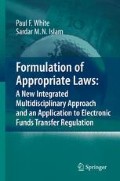As briefly discussed in the previous introductory chapter, there are limitations in the existing literature both in discussing EFT regulatory issues, generally, and in evaluating EFT regulatory options, in particular. The paucity of existing literature on EFT regulation omits any comparative and economic analysis, is somewhat dated, domestic-focused and mostly prepared in isolation by the various institutional stakeholders involved. EFT’s emerging dominance of the payments system in Australia and internationally requires an extended contemporary approach to discussing and evaluating regulatory issues and options as part of the quest for a more efficacious regulatory system (which is described in detail in Chapters 3, 4 and 5).
Accordingly, this chapter is structured as follows: In Section 2.1, the prior literature on EFT regulation is discussed and its limitations are highlighted. The history and emergence of EFT as a preferred payment method is examined in Section 2.2 and in Section 2.3 the risks in the consumer payments system generally, and for EFT in particular, are discussed. The focus in Section 2.4 is on whether pre-existing paper-based common law and contractual principles, as between banker and customer, have relevance and application to EFT payments. The advent and evolution of the Australian EFT Code of Conduct is considered in Section 2.5. The role of ASIC as Australia’s peak financial regulator is examined in Section 2.6 as well as examining the adverse trend prevalent in the ASIC EFT monitoring and compliance data. The discussion in Section 2.7 concerns the difficult role of the ABIO as the principal adjudicator of EFT disputes between financial institutions and consumers, while in Section 2.8, the Australian Code of Banking Practice is briefly reviewed to the extent that it relates, in small part, to the EFT Code and is also a self-regulating instrument. The role and relevance of the legislative force of the ASIC Act is considered in Section 2.9. In Section 2.10, the background and scope of the US EFT Act is examined and the conclusion to the chapter is presented in Section 2.11.
Access this chapter
Tax calculation will be finalised at checkout
Purchases are for personal use only
Preview
Unable to display preview. Download preview PDF.
Rights and permissions
Copyright information
© 2008 Springer-Verlag Berlin Heidelberg
About this chapter
Cite this chapter
(2008). The EFT System and Regulatory Framework. In: Formulation of Appropriate Laws: A New Integrated Multidisciplinary Approach and an Application to Electronic Funds Transfer Regulation. Springer, Berlin, Heidelberg. https://doi.org/10.1007/978-3-540-72047-8_2
Download citation
DOI: https://doi.org/10.1007/978-3-540-72047-8_2
Publisher Name: Springer, Berlin, Heidelberg
Print ISBN: 978-3-540-72046-1
Online ISBN: 978-3-540-72047-8
eBook Packages: Humanities, Social Sciences and LawLaw and Criminology (R0)

